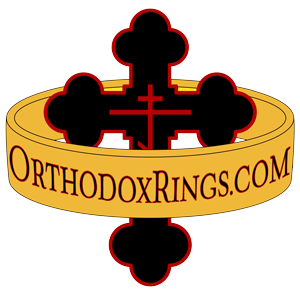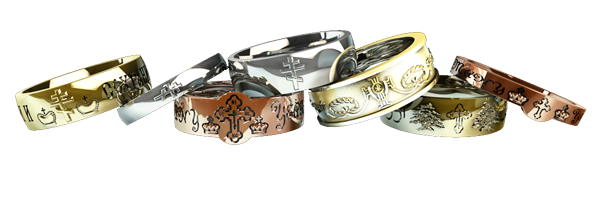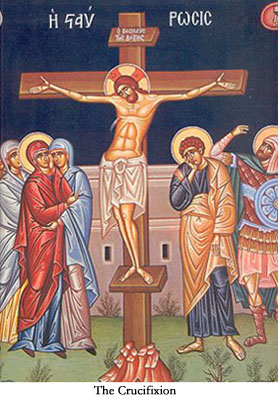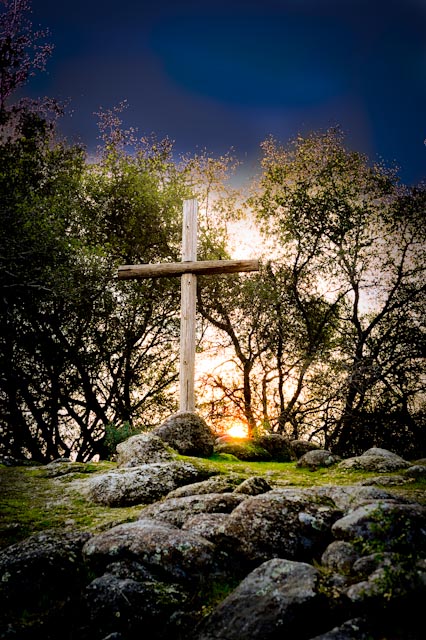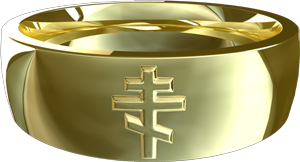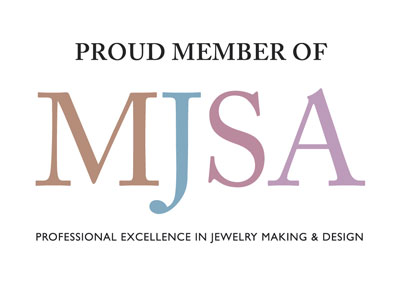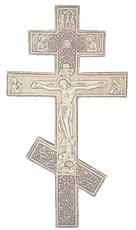1-888-949-RING (7464)
Free U.S. Shipping!*
Free Engraving!*
WEAR THE FAITH
*Except California
Follow Us!
~ Christian Designs ~
~ Traditional Designs ~
Articles > Rings
Name:
Email:
Comments:
Share Your Feedback
We truly appreciate all feedback from visitors regarding our website or products. Thank you.
If you would like a reply, please provide your email address. We will not use it for any other purpose.
Like this article?
As some of you may have guessed, the top bar of the three bar Orthodox cross is simply the extra piece that Pilate put there; "And Pilate wrote a title, and put it on the cross. And the writing was JESUS OF NAZARETH THE KING OF THE JEWS." (John 19:19, 20). Though this unique shape of Jesus's particular cross was formed out of an attempt at mockery, it instead became a "triumphant symbol that all nations would come under the reign of Jesus the King" (The Orthodox Study Bible). Eastern Orthodox crosses often replace Pilates ignorance on the top bar with "King of Glory" ("An Explanation"). The three bar cross is one way The Eastern Orthodox Church chooses not to forget Christ's earthly Kingship over the new Israel (Galatians 3:7-9 , Galatians 6:16).
The middle and longest bar of the three bar Orthodox crosses are, of course, the piece that Christ's arms were outstretched, to their limits, nailed, and then hung on. This is the bar in common with the Latin cross, the cross most revered by the Catholic Church and most often used by Protestants ("Christian Cross"). In one of the most breathtaking moments of all the services attended by Orthodox Christians during Holy Week (the week leading up to Easter) we sing:
"Today He who hung the earth upon the waters is hung on a tree.
The King of the Angels is decked with a crown of thorns.
He who wraps the heavens in clouds is wrapped in purple mockery.
He who freed Adam in the Jordan is slapped in the face.
The bridegroom of the Church is affixed to the cross with nails.
The Son of the virgin is pierced by a spear.
We worship Thy passion, O Christ.
Show us also Thy glorious resurrection..."
(15th Antiphon on Holy Friday).
The bottom bar, of the three bar cross, might be the most unfamiliar to Protestant Christians and it is how it has received its name as "The Cross of St. Andrew." Most obviously, the bottom bar depicts the footrest that supported Christ's body while He hung for hours. "The cruel death of a crucifixion was not brought about through blood loss, but by lack of oxygen: exhausted, the man is no longer able to stand straight up on the foot-rest, the body sags, and air can no longer be drawn in" ("Why does the Orthodox Cross"). Often this bottom bar is slanted, with the right side (from Christ's vantage point) elevated. There are many reasons that this has become tradition. One, with records dating back to at least the 6th century, is simply that it is believed that during His agony on the cross, just before He "gave up the Spirit," with the "curtain being torn in two," the "tombs being opened," and "earth quaking," the footrest that Christ's feet were on tilted (Saunders, Matthew 27:50-52). Another reason for the tradition of the bottom bar of the three bar Orthodox cross being slanted, with the right side elevated, is to remind us to emulate the "good thief," St. Dismas ("Dismas the thief"). This thief was on Christ's right side who repented and confessed Him at the last moment, and is therefore now most assuredly with the Lord in paradise. The thief on Christ's left did not repent and therefore follows the left side, of the bottom bar, away from God and paradise ("Three-Bar Cross," Luke 23:43).
Photo by Tori Ava Photography
St. Dismas
Order Online 24 Hours a Day, 7 Days a Week, 365 Days a Year!
© Copyright 2016 OrthodoxRings.com. All rights reserved.
All of our rings are MADE IN THE USA!
Do you have an idea for our next ring design?
OrthodoxRings.com presents...
by Matt Swagerty
The Eastern Orthodox cross often has three bars, and not many outside of Orthodoxy know why. "What's with the three bar cross on all of your rings?" This is one of the first questions I anticipated, from my Protestant friends, when I began an Orthodox jewelry company (OrthodoxRings.com). Well, the simple answer is that we are an Orthodox Christian jewelry company and the crosses on our rings are three bar because a high percentage of Orthodox crosses are three bar crosses. Okay, but "Why is the most well-known Eastern Orthodox cross a three bar cross?" "Is there meaning behind it unique from the one bar cross that Protestants use?" Is it just a Russian cross?" Since most of my Protestant friends have heard my "our Church was founded by the apostles" story, I figured I would come up with something a bit more poignant regarding the longtime defender of the Church, the three bar Orthodox cross.
In the Orthodox world, a world comprised of nearly 300 million people, it is a very natural thing to see the cross with three bars, and not only in Russia. It is on many of our churches, alters, jewelry, you name it… It is even in our worship. Here is a verse from Great Vespers of the major feast day of the cross in The Orthodox Church, September 14th, The Exaltation, or Elevation, of the Cross:
“O three-branched Cross of Christ,
you are my strong protection.
Sanctify me by your power,
that I may venerate and glorify you in faith and love!"
(“The Universal Exaltation (Elevation)”)
Let’s look at each of the three bars, of the Eastern Orthodox cross, and how they bring us closer to the event that took place on the cross and ultimately with the God-man that died there for us.
As this song continues, an icon of Christ is hung onto a cross at the front of the church, usually an Orthodox cross of some variation, and often a three bar cross.
Here is a verse The Orthodox Church sings, also during the Great Vespers service of The Exaltation of the Cross, sung the night before the feast, about our desired emulation of the repentant thief:
“O Christ our God, we sinners venerate with unworthy lips Thy precious Cross,
which Moses once prefigured in himself, when he overthrew Amalek and put him to flight; and which David the psalmist commanded to be venerated as Thy footstool. We cry aloud to Thee Who wast
pleased to be crucified upon it. O Lord, with the thief count us worthy of Thy Kingdom”
(“Great Vespers on September 13”).
The three bar cross has just as often been called the cross of St. Andrew or the Russian Orthodox cross, although its use well predates the Christianization of Russia, in 988 AD (Saunders, "Three-Bar Cross," "The Eastern Orthodox Cross"). Very early depictions of the crucifixion, even from Egypt, generally show a three bar cross ("Three-Bar Cross"). There are two events most given for it being called the cross of St. Andrew and the Russian Orthodox cross. First, St. Andrew is said to have predicted the evangelism of the Slavs, while preaching in southern Russia, and according to Russian tradition he was carrying a three bar cross ("The Eastern Orthodox Cross"). Then, a thousand years later, when Russia was Christianized, and eventually moved its center from Kiev to Moscow, it adopted St Andrew as its patron. As it did this, it began primarily using the three bar crosses, with the slanted lower bar, which created an X-shape, reminding all of St. Andrew, their patron, who was himself crucified on an X-shaped cross (Saunders, "Russian Orthodox Church").
Whether we call it the cross of St. Andrew, the Russian Orthodox cross, the Eastern Orthodox cross, or simply the Orthodox cross, we put it on our Orthodox jewelry, at Orthodox.Rings.com, because the three bar cross reminds us vividly of what happened at Christ's passion, while challenging us concerning our response to it. On the feast of The Exaltation of the Cross The Orthodox Church sings this amazing verse summarizing Christ’s gift to us through the cross:
“Come, all you nations, let us fall down in worship before the blessed Tree,
by which eternal justice has come to pass! For he who deceived Adam by a Tree
is caught by the lure of the Cross; and he who held under his tyranny
the creature endowed by God with royal dignity is brought down in a headlong fall.
The serpent's venom is washed away by the blood of God, and the curse of just condemnation
is undone when the Just One is condemned by an unjust judgment.
For it was fitting that the Tree should be healed by a Tree, and that by the
Passion of the passionless God what was wrought on the Tree should destroy the passions of man,
who was condemned. But glory to Your dread dispensation for our sakes, O Christ the King,
through which You have saved us all since You are good and the Lover of mankind!”
(“The Universal Exaltation (Elevation)”)
We remember that our Lord is King, that He hung on a tree for our sakes and that we must follow Him, confess Him, and repent. If we respond to His love at all, no matter how corrupt we are, and no matter how long we have waited, we can fix our eyes on the lower bar of the three bar Orthodox cross and pray earnestly one of the daily prayers of the Orthodox Church:
"O Christ God, at the ninth hour You tasted death in the flesh for our sake:
mortify the rebellion of our flesh and save us!
In the midst of two thieves, Your Cross was revealed as the balance-beam of righteousness.
For while the one was led down to hell by the burden of his blaspheming,
the other was lightened of his sins to the knowledge of things divine.
O Christ our God, glory to You!" ("Daily Cycle")
References:
- "An Explanation of the Traditional Russian Orthodox Three-bar Cross." Synaxis.Info. http://www.synaxis.info/old-rite/0_oldbelief/instructional_eng/cross_symbolism.html. April 4, 2013.
- "Christian Cross." http://en.wikipedia.org/wiki/Christian_cross. Wikipedia. April 4, 2010.
- "Daily Cycle or Hours of Prayer in the Church." Daily Prayer. http://www.orthodoxprayer.org/Hours.html. April 4, 2013.
- "Dismas the thief." Orthodox Wiki. http://orthodoxwiki.org/Dismas_the_thief. April 7, 2013.
- “Great Vespers on September 13 Exaltation of the Holy Cross.” Antiochian Orthodox Christian Archdiocese of North America Diocese of Los Angeles and the West. http://www.antiochianladiocese.org/files/service_texts/great_feasts/lord_holycross/Sept-13-VESP.pdf. September 13, 2013.
- "Russian Orthodox Church." Wikipedia. http://en.wikipedia.org/wiki/Russian_Orthodox_Church. April 4, 2013.
- Saunders, Fr. William. "The Eastern Cross." http://catholiceducation.org/articles/religion/re0204.html. April 7, 2013.
- "The Eastern Orthodox Cross." Seiyaku.com. http://www.seiyaku.com/customs/crosses/eastorth.html. April 4, 2013.
- "The Orthodox Study Bible." Luke 23:38 Commentary. USA. Thomas Nelson, 2008.
- “The Universal Exaltation (Elavation) of the Precious and Life-giving Cross.” Orthodox Church in America. http://oca.org/liturgics/service-texts. September 13, 2013.
- "Three-Bar Cross." Orthodox Church in America. http://oca.org/questions/liturgicarts/three-bar-cross. April 4, 2013.
- "Why does the Orthodox Cross have Three Bars?" A Reader's Guide to Orthodox Icons. http://iconreader.wordpress.com/2010/07/20/the-cross/. April 4, 2013.
Matt Swagerty is the co-founder of OrthodoxRings.com, a web-based Orthodox Christian business dedicated to providing precious metal Orthodox Christian rings and wedding bands to people of the ancient Christian Faith worldwide.

